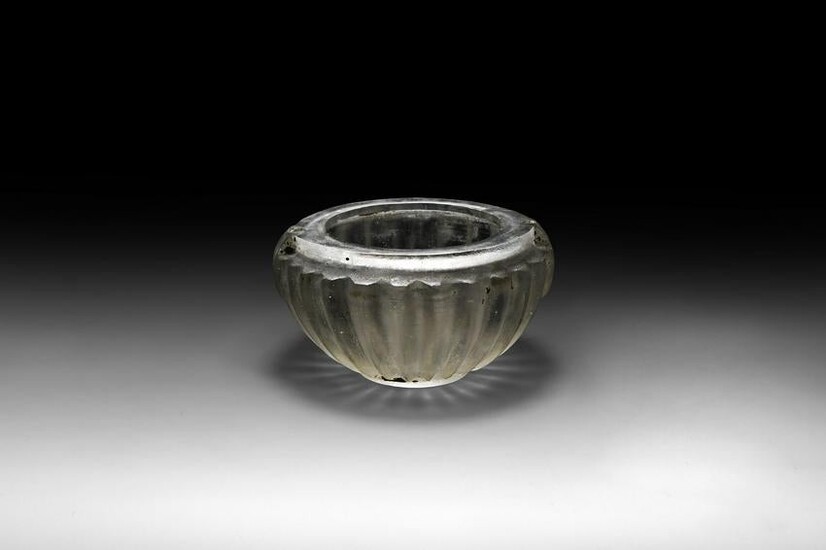Hellenistic Ribbed Glass Vessel
3rd-2nd century BC. A miniature glass bowl with circumferential band of vertical ribbing to the exterior wall, broad flat rim incorporating two shallow lateral blocks, pierced to accept a handle. 148 grams, 82mm (3 1/4"). From an important English collection; previously in collection H.B. since 2012; formerly in a French private collection; acquired from Galerie Serres, Paris, before 1980; this lot has been checked against the Interpol Database of stolen works of art and is accompanied by AIAD certificate number no. 10799-177451. Glassmaking and glass working were considered to be two separate crafts and took place in different regions in the Hellenistic period. Each craft was characterised by its own technological tradition, know-how and equipment. Glassmakers and glassworkers did not need to have an understanding of glass vessel manufacture and primary production respectively, in order to carry out their tasks. Glassmaking had to take place as close as possible to the sources of the raw materials used, namely sand and mineral natron when it comes to the Hellenistic period. Raw glass was traded throughout the Mediterranean in the form of ingots and it was then worked and shaped into vessels, inlays, jewellery, etc, in numerous sites of the Hellenistic world. A large part of glass production took place on the Syro-Palestinian Coast as well as the broader Levant and Egypt, with centres of manufacture in the royal capitals of Antioch and Alexandria. The reputation of the Alexandrian workshop is well understood from luxury glass vessels decorated with Egyptian-style buildings or characteristic scenes found as far as Italy and Afghanistan. [A video of this lot can be viewed on the Timeline Auctions website]
Condition Report: Fine condition; traces of sinter, one small crack.
View it on
Estimate
Time, Location
Auction House
3rd-2nd century BC. A miniature glass bowl with circumferential band of vertical ribbing to the exterior wall, broad flat rim incorporating two shallow lateral blocks, pierced to accept a handle. 148 grams, 82mm (3 1/4"). From an important English collection; previously in collection H.B. since 2012; formerly in a French private collection; acquired from Galerie Serres, Paris, before 1980; this lot has been checked against the Interpol Database of stolen works of art and is accompanied by AIAD certificate number no. 10799-177451. Glassmaking and glass working were considered to be two separate crafts and took place in different regions in the Hellenistic period. Each craft was characterised by its own technological tradition, know-how and equipment. Glassmakers and glassworkers did not need to have an understanding of glass vessel manufacture and primary production respectively, in order to carry out their tasks. Glassmaking had to take place as close as possible to the sources of the raw materials used, namely sand and mineral natron when it comes to the Hellenistic period. Raw glass was traded throughout the Mediterranean in the form of ingots and it was then worked and shaped into vessels, inlays, jewellery, etc, in numerous sites of the Hellenistic world. A large part of glass production took place on the Syro-Palestinian Coast as well as the broader Levant and Egypt, with centres of manufacture in the royal capitals of Antioch and Alexandria. The reputation of the Alexandrian workshop is well understood from luxury glass vessels decorated with Egyptian-style buildings or characteristic scenes found as far as Italy and Afghanistan. [A video of this lot can be viewed on the Timeline Auctions website]
Condition Report: Fine condition; traces of sinter, one small crack.



